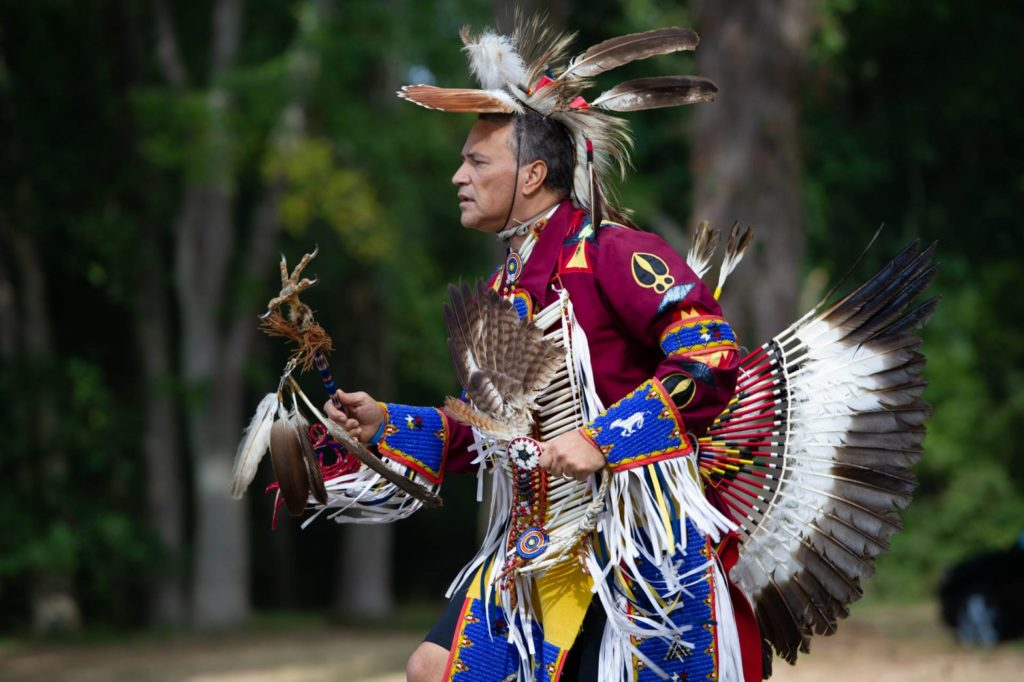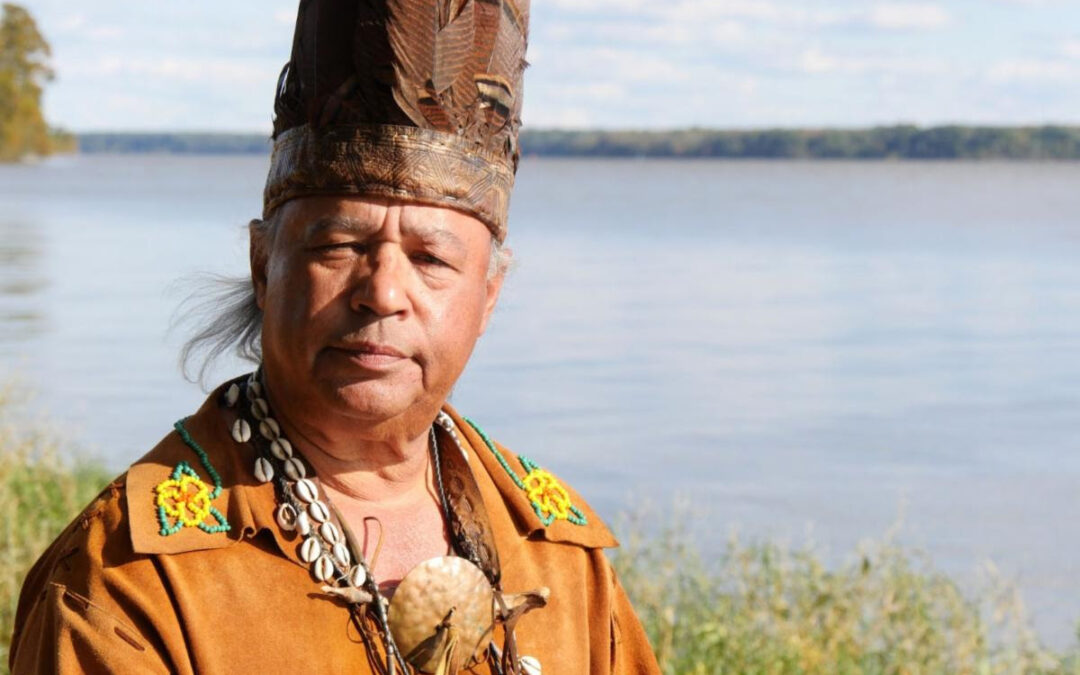Stephen Adkins, Chief of the Chickahominy Tribe
Written by Jamal Childs
In the heart of Virginia, resting in the embrace of fertile farmlands, forest and winding rivers, the Chickahominy Tribe has woven its story for centuries. Chief Stephen Adkins, a guardian of tradition and a resilient leader guiding his people, stands at its helm. Recent conservation success through what is known as “land back” has kindled a flame of hope as they journey to reclaim their ancestral lands.
The land back movement has important implications for conservation in the region. The Chickahominy Tribe’s journey for “land back” is not just about land conservation or legalities; it’s spiritual and motivating. For example, at the end of December 2021, a conservation easement on the “Mamamanahut Peninsula” in Charles City, Virginia, also known as “Willcox Neck,” permanently conserved 800 acres and put them back in Tribal hands. The acquired land holds not only physical space but also the stories and echoes of ancestors. Chief Adkins has stated that “when we walk on that property, there is a sense of our ancestors that we feel as we walk through the gate.”
Why is the land back movement important? It is a call for justice and recognition, a soulful reconnection to a stolen identity. Chief Adkins recognizes that the land is not something to own but a gift from nature that must be respected. The Mamamanahut Peninsula is right on the ancestral river, which cradles the Chickahominy people’s history. Their Tribal headquarters is just 10 miles away from the Chickahominy River, where they hold powwows,follow ancient customs and regard the location of their Tribal center as sacred.
Before the 1600s, the sacred ground witnessed the Tribe’s dance, ceremony and resilience for centuries. However, in 1607, when the colonists first landed, the Tribe was forced into treaties with different monarchs from Europe. Despite adversity, the Chickahominy have clung to their heritage, surviving the atrocities followed by the Papal Bull issued by Pope Nicholas the V to King Ferdinand V of Portugal in 1552. Ancestors were removed from their lands in 1645. The Chickahominy are survivors, as the “Doctrine of Discovery” or the Papal Bull, represents the age of discovery, manifest destiny and colonialism. These ideologies enabled attempts to annihilate Indigenous peoples and neighboring Tribes.
Forced migrations fractured vibrant villages and towns, erasing traditional lifestyles and languages. The colonists adopted aspects of Chickahominy culture, robbing the Tribe of its identity. Access to their ancestral lands and waterways became a privilege as they were swindled out of their rights. The Chickahominy finally earned federal recognition in 2018. This huge step allowed them to seize an opportunity to purchase sacred land in 2021.

Chickahominy Tribal leaders blessed the return of another ancestral land parcel in 2019.
Willcox Neck holds profound significance for the Chickahominy Tribe. Serving as a legal agreement between the Tribe and relevant authorities, the easement plays a pivotal role in preserving the cultural, heritage and natural essence of the Chickahominy’s ancestral land. This arrangement ensures that the land retains its historical and cultural values by preventing certain types of development that could compromise its significance.
Beyond cultural preservation, the conservation easement incorporates provisions for environmental protection, safeguarding the ecological balance of the land. By applying this legal mechanism, the Chickahominy Tribe not only protects against future undesirable developments but also secures formal recognition of their ancestral rights to the land. The use of a conservation easement becomes emblematic of the Tribe’s harmonious approach to land ownership, reflecting a commitment to preserving the physical, cultural and natural elements that make the Mamamanahut Peninsula sacred to them. In essence, the conservation easement is a powerful tool permitting the Chickahominy Tribe to reclaim and protect their ancestral land, ensuring its integrity for generations to come.

Chickahominy River
The Chickahominy Tribe’s journey unfolds as a narrative of reclamation through conservation. Chief Adkins, driven by the spirits of his forefathers, seeks coexistence with the land. Through faith and an indomitable spirit, the Chickahominy reclaimed property significant to their people. The Tribe’s recent success is a testament to endurance, pride and unity.
Conservation can take various practical forms. As the Chickahominy Tribe triumphantly reclaims their land, Chief Adkins declares, “We are not done. We will continue to gather land. It might not be conservation, but we will remain environmentally friendly.”
Chief Adkins desires understanding—an invitation for others to grasp the journey, to be welcoming and to acknowledge the Indigenous connection to the land. In Chief Adkins’ words, “You can not inspire others if you keep your successes to yourself.” Sharing successes, languages and culture is vital. Awareness must extend beyond one tribe or one group. Despite seeming impossible, the journey demands consistent work towards your goal. Mistakes and missteps are part of progress; they shouldn’t deter but guide.” The Chickahominy Tribe’s story for land back is monumental, not just of reclamation but of shared struggles and collective victories.
The Chief reminds us about the importance of sharing successes, not just for the Chickahominy Tribe but for all tribes and communities. Their journey is a testament that dreams can come true, but they demand perseverance, awareness and collective effort.
A complete recording of Chief Adkins’ inspirational keynote speech at the 2023 CCP Annual Meeting and the Chesapeake Gateways Annual Training.
Image credit:
- Scott McDaniel
- Office of the Governor of Virginia
- DHouv (Photographer)
Lightning Update is a regular communication of the Chesapeake Conservation Partnership. Any opinions expressed are those of the authors and do not necessarily reflect positions of the Partnership or member organizations.
To share a success story, news, or important event, send your information to:
Support for the Chesapeake Conservation Partnership is provided by:
National Park Service Chesapeake
EPA Chesapeake Bay Program
USDA Forest Service
Pennsylvania Department of Conservation & Natural Resources
Maryland Department of Natural Resources
Virginia Outdoors Foundation
US Fish & Wildlife Service
Chesapeake Conservancy
The Chesapeake Conservation Partnership is co-convened by:




